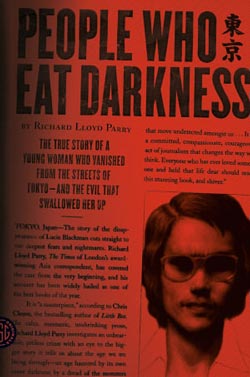
The research montage. CE readers know what I’m talking about. Whether it’s Cumberbatch sherlocking around a crime scene, the Doctor Who or Torchwood gang banging away on impossible, alien computers, or the CSI crew banging away on even more impossible, alien computers, the research montage is a key part of crime and science fiction television. Usually the montage has some sort of fast-paced electronic music thumping underneath it and shocking clues are unearthed.
Research is cool.
Richard Lloyd Parry’s People Who Eat Darkness is a testament to research, and how it can be used to completely immerse a reader in a dark tale. Darkness tells the true story of Lucie Blackman, a twenty-one-year-old British woman abducted in Tokyo in 2000. This book isn’t only the story of Blackman’s disappearance; it’s also the story of her entire life, her family’s life, the life of her killer and, to a lesser extent, a history of Japan. This massive book is built on a foundation of interviews, newspaper articles, trial transcripts, official evidence, and tons of endnotes. Parry is the Tokyo bureau chief of The Times (London) and the man knows how to layer information, often dense historical information, in a way that pulls the reader deep into the mystery.
Lloyd Parry covered Blackman’s disappearance at the time and the book demonstrates his mastery of this extraordinarily bizarre and complex case. The book preserves the mystery of Lucie’s disappearance and doesn’t reveal the full story until nearly the end. Lloyd Parry maintains suspense in part by delving into precise detail.
For example, Blackman worked in a hostess bar in Roppongi—a somewhat Americanized neighborhood in Tokyo. Hostess bars allow Japanese businessmen to pay for the company of women who are usually American or European. Lloyd Parry not only explains the rules and tradition of the hostess bars—no touching or sex, only flirting and compliments—but also provides the reader with a detailed history of Japanese establishments that combine drinking and sexuality. We get a sketch of the first hostess clubs that emerged after World War II, and a history of the other, seedier clubs. And not just for a paragraph or two. Instead, there are pages and pages about this interesting wrinkle in Japanese culture.
Lloyd Parry’s book is a triumph because he not only tells a dramatic and tragic story, but the detail provides a real texture. The incompetence of the Tokyo Police Department becomes an important factor in the book—really, they mess up so many different parts of this case it’ll make you nervous to go to Japan. Yet Lloyd Parry wants to tell a balanced story, so he provides a long history of the highlights and lowlights of Japanese law enforcement that helps the reader understand the strengths and weaknesses of Japanese police. There are no easy scapegoats in this book.
Lucie Blackman and her family get the same in-depth treatment. We’re told not only about Lucie’s childhood but her mother’s and father’s upbringing as well. We get access to Lucie’s diaries, her letters back home, and intimate interviews with her family members.
The parents of the missing girl sometimes come across very badly, and sometimes even Lucie herself is portrayed in a negative light. When a man, Kenji Obara, is arrested for her death Lloyd Parry resists the urge to paint him as a monster. Instead, we’re provided with Obara’s fascinating and tragic family background and a compressed history of the tension between native Japanese and ethnic Koreans.
These digressions are never boring. Instead, the history is necessary to transport the reader to Tokyo and give us more awareness of a culture very different from ours. Despite its length, the book is a quick read because the case is so fascinating and the research is so interesting.
Reading People Who Eat Darkness is a wrenching experience. Not only because of the grisly details of the case, although there’s plenty of blood and graphic violence, but because the details tell a complex, human story. Closing the book, I felt like I not only knew Lucie Blackman and her family, but also her killer and Tokyo itself. This is how true crime books are supposed to make readers feel.
Richard Z. Santos lives outside of Austin and is enrolled in the MFA program at Texas State University. Once, he worked in Washington, DC, but now he doesn’t do much more than write and teach. He blogs at Paperclip People, and is working on his first novel—a crime thriller set in New Mexico.

This book is fantastic. I can’t recommend it enough. Lloyd Parry spent a decade following this story and it shows. It’s as much about the criminal justice system in Japan as it is about the hunt for Lucie’s killer. Go read it NOW.